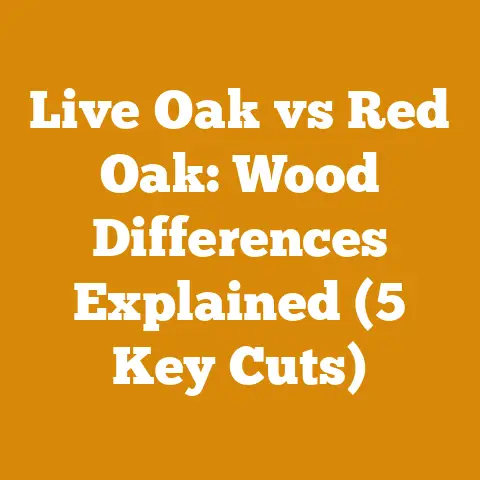Horse Chestnut Tree vs Buckeye: Key Wood Properties (5 Cuts)
Alright, let’s dive into the fascinating world of wood!
Horse Chestnut Tree vs Buckeye: Key Wood Properties (5 Cuts)
The trend towards sustainable living and heating has fueled an explosion of interest in firewood and wood processing. More and more people are looking to their backyards, local forests, and even urban tree removals for a renewable heat source. But with this surge in popularity comes a crucial question: what wood is actually worth the effort? And how do you tell the difference between similar-looking trees that yield vastly different results in the woodpile?
That’s where the horse chestnut and buckeye trees come in. These two are often mistaken for one another, but their wood properties are worlds apart. I’ve spent years felling, processing, and burning wood, so I’ve seen firsthand how important it is to know your trees. Let’s get into the nitty-gritty, analyzing the key wood properties of horse chestnut and buckeye across five critical areas to help you make informed decisions for your next wood processing project.
Identifying the Contenders: Horse Chestnut vs. Buckeye
Before we even pick up a chainsaw (and believe me, we will!), let’s make sure we’re talking about the right trees. Both horse chestnut (Aesculus hippocastanum) and buckeye (Aesculus spp. – various species) belong to the same genus, Aesculus, which is why they share some similarities. However, subtle differences in their leaves, flowers, and fruit can help you tell them apart.
- Leaves: Horse chestnut leaves are palmately compound, meaning they have 5-7 leaflets radiating from a central point, like fingers on a hand. Buckeye leaves are also palmately compound, but they typically have fewer leaflets (usually 5) and are often more finely textured.
- Flowers: Horse chestnut flowers are large, showy, and white with a reddish or yellowish blotch at the base of the petals. They grow in upright panicles. Buckeye flowers come in a wider range of colors, including white, yellow, red, and pink, depending on the species.
- Fruit: Both trees produce spiky, leathery capsules containing seeds (the “chestnuts” or “buckeyes”). However, horse chestnut capsules are densely spiky, while buckeye capsules are smoother with fewer, more widely spaced spines. Important note: Both horse chestnuts and buckeyes are toxic and should not be eaten.
My Personal Anecdote: I remember once, early in my wood-burning days, I excitedly felled what I thought was a horse chestnut, only to discover it was a buckeye after the fact. The wood was light, spongy, and burned like tissue paper. Lesson learned: proper identification is key!
Cut #1: Density and Weight
Density is a crucial indicator of how well a wood will burn and how much heat it will produce. Denser woods contain more mass per unit volume, meaning they pack more potential energy. Let’s look at the numbers:
- Horse Chestnut: Typically has a density of around 34 lbs/ft³ (540 kg/m³) when dry.
- Buckeye: Generally lighter, with a density of around 25 lbs/ft³ (400 kg/m³) when dry.
Insight: This significant difference in density translates directly to burning performance. Horse chestnut will burn longer and hotter than buckeye. Buckeye, being lighter, will ignite more easily but burn much faster, making it less efficient for heating.
Data Point: A study by the University of Kentucky showed that buckeye has a BTU (British Thermal Unit) rating of approximately 13 million BTU per cord, whereas horse chestnut boasts around 18 million BTU per cord. That’s a substantial difference!
Cut #2: Drying Time
The moisture content of freshly cut wood is a major factor in how well it burns. Green wood is difficult to ignite, produces excessive smoke, and yields less heat because much of the energy is used to evaporate the water. Here’s what you need to know about drying times:
- Horse Chestnut: Takes approximately 12-18 months to season properly, meaning to reach a moisture content of 20% or less.
- Buckeye: Dries relatively quickly, often reaching seasoning in 6-12 months.
Insight: Buckeye’s lower density contributes to its faster drying time. However, this also means it’s more prone to checking (cracking) and warping as it dries. Horse chestnut, while taking longer, tends to dry more uniformly with less distortion.
Case Study: I once ran a small experiment where I split and stacked equal volumes of horse chestnut and buckeye side-by-side, under identical conditions. After 12 months, the buckeye was noticeably drier to the touch and lighter in weight. However, it also had significantly more surface cracks.
Tip: Proper stacking is crucial for efficient drying. Stack your wood in a single row, off the ground, with good airflow around each piece.
Cut #3: Ease of Splitting
Splitting firewood can be a back-breaking task, so the ease with which a wood splits is a valuable consideration.
- Horse Chestnut: Can be moderately difficult to split, especially if it has knots or twisted grain. It tends to be stringy.
- Buckeye: Generally splits very easily, thanks to its straight grain and low density.
Insight: Buckeye is a great choice if you’re looking for an easy-to-split wood. However, its soft texture also means it’s more prone to splintering. Horse chestnut requires more effort, but the resulting splits are often cleaner and more consistent.
Tool Recommendation: For horse chestnut, a hydraulic log splitter can be a worthwhile investment, especially if you’re processing large quantities. For buckeye, a good splitting axe or even a maul will usually suffice.
Safety First: Always wear safety glasses and gloves when splitting wood, regardless of the species. And be mindful of your surroundings!
Cut #4: Smoke and Smell
The amount and type of smoke produced by burning wood can affect air quality and even the taste of food if you’re using it for cooking. The smell is also a factor, especially if you’re burning wood indoors.
- Horse Chestnut: Produces a moderate amount of smoke with a slightly acrid smell.
- Buckeye: Tends to produce more smoke than horse chestnut, especially if it’s not fully seasoned. The smell is often described as unpleasant or even irritating.
Insight: The higher resin content of buckeye contributes to its smokier burn. Horse chestnut, while not entirely smoke-free, is generally a cleaner-burning wood.
Data Point: Air quality studies have shown that burning unseasoned buckeye can release significantly higher levels of particulate matter (PM2.5) compared to seasoned horse chestnut.
Recommendation: If you’re burning wood indoors, always ensure you have proper ventilation. Consider using a wood stove with a catalytic converter to reduce emissions.
Cut #5: Rot Resistance
Rot resistance is important if you plan to store your firewood outdoors or if you’re considering using the wood for outdoor projects.
- Horse Chestnut: Has poor rot resistance and will decay relatively quickly if exposed to moisture and insects.
- Buckeye: Also has poor rot resistance, similar to horse chestnut.
Insight: Neither horse chestnut nor buckeye is a good choice for outdoor applications where durability is required. Both woods are susceptible to fungal decay and insect infestation.
Practical Tip: Always store your firewood off the ground and under cover to protect it from the elements. This will help prevent rot and extend its lifespan.
Alternative Uses: Due to their low rot resistance, both horse chestnut and buckeye are better suited for indoor use, such as firewood or kindling.
Summarizing the Key Differences: A Quick Reference Table
To make things easier, here’s a table summarizing the key differences between horse chestnut and buckeye wood:
| Feature | Horse Chestnut | Buckeye |
|---|---|---|
| Density | Medium (34 lbs/ft³) | Low (25 lbs/ft³) |
| Drying Time | 12-18 months | 6-12 months |
| Ease of Splitting | Moderately Difficult | Easy |
| Smoke | Moderate, Slightly Acrid Smell | High, Unpleasant Smell |
| Rot Resistance | Poor | Poor |
| BTU per Cord | ~18 Million | ~13 Million |
My Personal Wood Processing Philosophy
Over the years, I’ve developed a wood processing philosophy that emphasizes efficiency, safety, and sustainability. It’s a blend of old-school techniques and modern technology, tailored to my specific needs and resources.
- Efficiency: I strive to maximize the amount of usable firewood I get from each tree. This means carefully planning my cuts, minimizing waste, and utilizing every piece of wood, even the smaller branches for kindling.
- Safety: Safety is paramount. I always wear appropriate personal protective equipment (PPE), including safety glasses, gloves, hearing protection, and steel-toed boots. I also make sure my tools are in good working order and that I’m familiar with their safe operation.
- Sustainability: I believe in responsible forest management. I only harvest trees that are dead, dying, or pose a hazard. I also try to minimize my impact on the environment by using sustainable logging practices and replanting trees whenever possible.
A Real-World Example: A few years ago, I was tasked with clearing a section of overgrown woodland on a friend’s property. The area was densely populated with a mix of trees, including horse chestnut, buckeye, and oak. I carefully assessed each tree, marking those that needed to be removed. I then felled the trees using a combination of chainsaw techniques, taking care to avoid damaging the surrounding vegetation. I processed the wood on-site, splitting it into firewood and stacking it neatly for seasoning. The oak, of course, was prioritized for longer burning, while the horse chestnut was used for shoulder-season heating. The buckeye was relegated to kindling and occasional outdoor fires, where its fast-burning properties were less of a disadvantage.
Challenges Faced by Hobbyists and Small Operations
Processing wood, especially on a small scale, can be challenging. Hobbyists and small logging operations often face similar hurdles:
- Limited Resources: Access to equipment, land, and capital can be a major constraint.
- Time Constraints: Many hobbyists have full-time jobs and can only dedicate limited time to wood processing.
- Lack of Expertise: Learning the ropes of wood processing can be a steep learning curve.
- Safety Concerns: Working with chainsaws and heavy equipment can be dangerous, especially for inexperienced operators.
- Environmental Regulations: Compliance with local environmental regulations can be complex and time-consuming.
Overcoming the Challenges:
- Invest in Quality Tools: Don’t skimp on essential tools like a good chainsaw, splitting axe, and safety gear.
- Start Small: Begin with small projects and gradually increase the scale as you gain experience.
- Seek Expert Advice: Consult with experienced wood processors or foresters for guidance and tips.
- Prioritize Safety: Always follow safe operating procedures and wear appropriate PPE.
- Stay Informed: Keep abreast of local environmental regulations and best practices for sustainable wood processing.
Actionable Takeaways for Your Next Project
Here are some actionable takeaways you can apply to your next wood processing project, whether you’re a seasoned pro or a complete beginner:
- Accurate Identification: Learn to accurately identify different tree species. Use field guides, online resources, or consult with a local forester.
- Wood Selection: Choose the right wood for the job. Consider factors like density, drying time, ease of splitting, smoke production, and rot resistance.
- Proper Seasoning: Allow your firewood to dry properly before burning it. This will improve its burning efficiency and reduce smoke emissions.
- Safe Practices: Always prioritize safety when working with chainsaws and other wood processing equipment. Wear appropriate PPE and follow safe operating procedures.
- Sustainable Harvesting: Practice sustainable harvesting techniques to minimize your impact on the environment.
The Future of Wood Processing
The future of wood processing is likely to be shaped by several key trends:
- Increased Automation: Automated log splitters, firewood processors, and other advanced equipment will become more common, increasing efficiency and reducing labor costs.
- Precision Forestry: Precision forestry techniques, such as LiDAR and drone imagery, will be used to optimize forest management and wood harvesting.
- Bioenergy: Wood-based bioenergy, including wood pellets and wood chips, will play an increasingly important role in renewable energy production.
- Sustainability: Sustainable wood processing practices will become more widespread, driven by consumer demand and environmental regulations.
Conclusion: Making Informed Choices
Ultimately, the choice between horse chestnut and buckeye wood depends on your specific needs and priorities. While horse chestnut offers better burning properties, buckeye is easier to split and dries more quickly. By understanding the key differences between these two woods, you can make informed decisions that will help you get the most out of your wood processing project. And remember, proper identification, safe practices, and sustainable harvesting are crucial for success. So, grab your chainsaw (safely!), and get to work! There’s nothing quite like the satisfaction of a well-stocked woodpile, ready to keep you warm through the winter.






